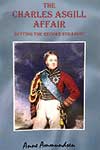|
THE CHARLES ASGILL AFFAIR
by Anne Ammundsen

|
Although all Grenadiers are well aware that the Regiment was formed by King Charles II in 1656, for many a cloud of uncertainty descends if they are asked anything about our regimental history between then and the Battle of Waterloo in 1815. For most, these are the dark ages!
History has been unkind about the standing of some soldiers, and this fascinating, well researched book seeks to restore the reputation of a young officer in the First Guards. The author, Anne Ammundsen, is descended from this man and she has spent more than 20 years in research, much of it based on primary sources.
Charles Asgill was born in April 1762 to a successful, wealthy banker, Sir Charles Asgill Bt, who had been Lord Mayor of London, who was known for his charitable work and support of hospitals, and who had commissioned the Golden Coach, which is still in evidence in the City at the annual Lord Mayor’s Show. He was created a Baronet in 1761.
The young boy was educated at Westminster School and might easily have followed his father into the world of finance, but he had other ideas and ambitions. Instead, he wanted to be a soldier and so, as was entirely normal then, Sir Charles purchased a commission for his son, who become an ensign in the First Guards in 1778, aged just fifteen. The book goes on to recount that this was the time of the American Wars of Independence and, since 1776, a detachment of thirty-five officers and 1100 soldiers from the three regiments of Foot Guards were in America, often in the thick of fighting. They regularly sustained casualties and needed replacements. Early in 1781 and by then an 18-year-old lieutenant (and captain in the Army; the dual ranking system in place at the time ultimately worked against him) the young Asgill departed for the Americas.
The book describes the fighting in considerable detail and the growing reputation and heroics of Asgill; but it came to nought as the British forces, led by Cornwallis, were encircled at Yorktown by American troops commanded by General George Washington and forced to capitulate. This had far-reaching consequences, forcing Britain into peace negotiations. Out of this America had gained her independence and Britain had lost valuable colonies in North America.
Asgill then became a prisoner-of-war. The captive army was marched to York, Pennsylvania and the soldiers placed in a stockade, while the officers were granted local parole. The coastal regions of New Jersey remained a region where small-scale but fierce warfare still raged, often between parties of militia and refugees and, in late March 1782, Philip White, a New Jersey Loyalist who had fled to New York and taken up arms in support of the British, was captured by American militiamen and promptly murdered.
Enraged Loyalists vowed revenge and an American officer, New Jersey Militia Captain Joshua Huddy, was soon implicated in White’s murder, arrested and hanged. This was the moment for George Washington to intervene and put an end to these tit-for-tat encounters, but instead he made a far more controversial move and called for further retaliation. The story then goes into great detail about the choice of Captain Asgill, as the officer to be mistreated and suffer retribution, even death, for the murder of Huddy.
Nevertheless, Asgill survived, was released and eventually returned home. The truth had been deliberately suppressed and many would have been broken by the experience, but Asgill persevered and he would go on to high rank. This is an exciting tale, much of it revolving around George Washington’s determination to preserve his own reputation at any cost and the deliberate sullying of Asgill’s name for as long as he lived. Indeed, his reputation never recovered from George Washington’s account of events in the 1786 American press. This welcome book now sets the record straight by throwing more light onto a little-known period of our history. Overall, Anne Ammundsen is to be congratulated for her meticulous research, which restores the reputation of a fine officer.
James Gatehouse
Heritage Bools
heritagebooks.com |
|

